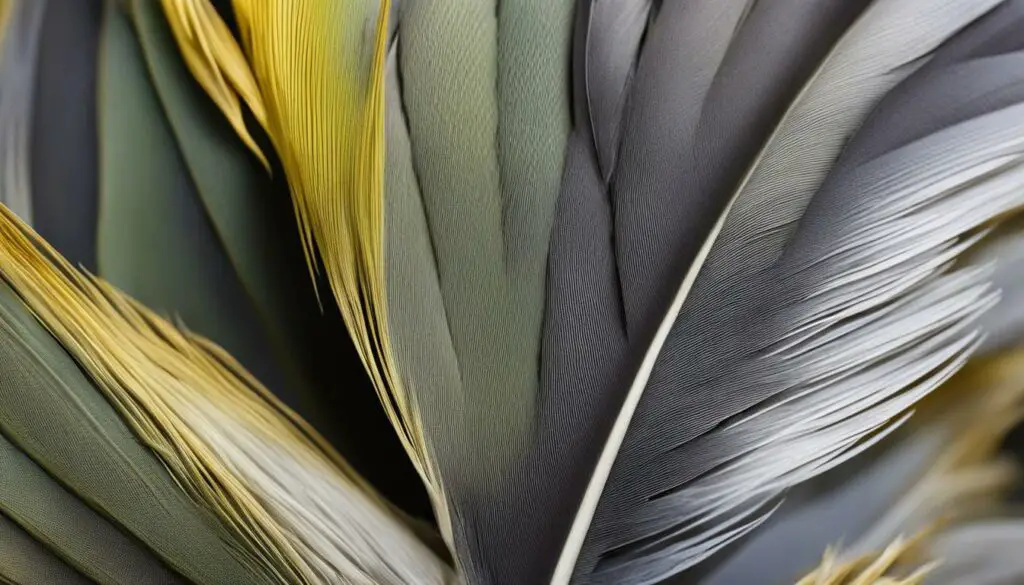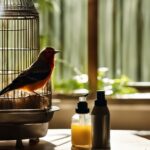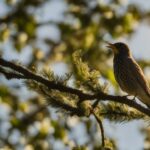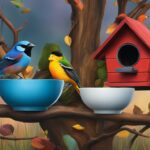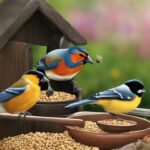As a proud cockatiel owner, I understand the importance of providing the best care for these friendly and charming members of the parrot family. One crucial aspect of cockatiel care is ensuring the health and beauty of their feathers. In this guide, I will share essential tips and techniques for feather care, including grooming, molting, and protecting your cockatiel from toxic substances and plants.
Key Takeaways:
- Regular grooming is essential for maintaining your cockatiel’s feathers and fostering trust and communication.
- Clipping your cockatiel’s wing feathers can help prevent accidents and create a stronger bond.
- Trimming toenails is important for your cockatiel’s comfort and safety.
- Avoid exposing your cockatiel to toxic plants and substances that can be harmful to their health.
- Providing a safe and stimulating environment is crucial for the overall well-being of your cockatiel.
Clipping Your Cockatiel’s Wing Feathers: A Step-By-Step Guide
Clipping your cockatiel’s wing feathers is an important aspect of their care and bonding process. When done correctly, it can help ensure their safety and strengthen the trust between you and your feathered friend. Here is a step-by-step guide to clipping your cockatiel’s wing feathers:
Gather the necessary tools:
- Small bird nail clippers or scissors
- Styptic powder or cornstarch (in case of bleeding)
- A towel or small cloth to wrap your cockatiel gently
Find a quiet and well-lit area to perform the procedure. It is essential to remain calm and confident, as your bird can sense your emotions. Approach your cockatiel slowly, speaking in a soothing voice to reassure them. Wrap your bird gently in the towel, exposing one wing at a time.
“When clipping the wings, it’s important to avoid cutting too close to the body, as this can cause pain and injury. The goal is to trim only the flight feathers on the wings, leaving a sufficient length to ensure gliding but preventing full flight.”
Inspect the wings for any long, protruding feathers known as “primary flight feathers.” These are the feathers that provide the most lift during flight. Use the nail clippers or scissors to carefully trim off the tips of these feathers, making sure to leave a small amount intact. Avoid cutting close to the body or the secondary feathers, as this can cause discomfort and hinder your bird’s ability to glide.
After you’ve finished trimming one wing, repeat the process with the other wing. Take breaks in between wings if necessary to allow your cockatiel to relax. Remember, wing clipping is a personal choice, and the extent of feather trimming may vary based on your bird’s behavior and preferences. Consult with a veterinarian or an experienced avian professional for guidance if needed.
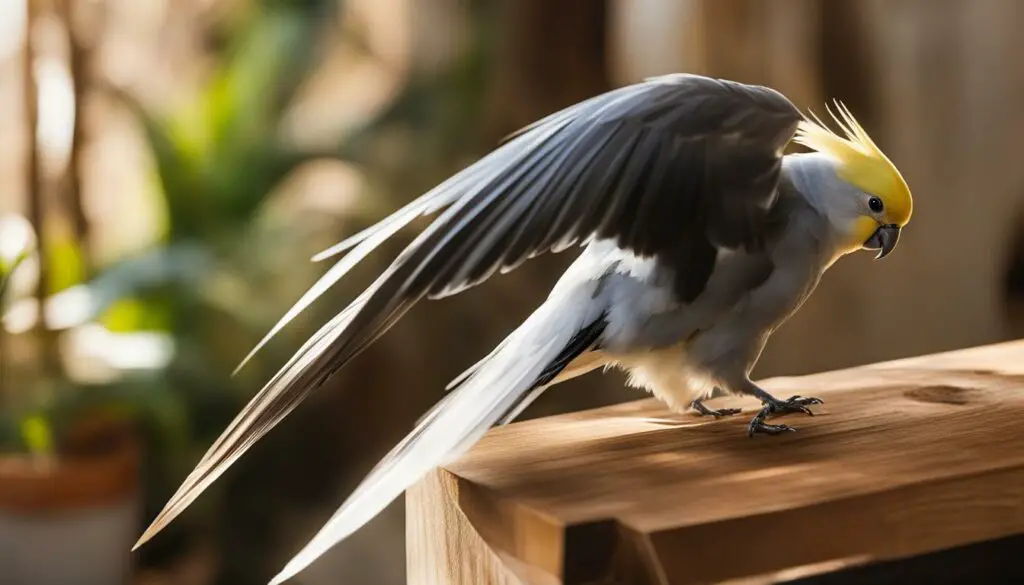
Table: Feather Clipping Procedure Summary
| Step | Description |
|---|---|
| 1 | Gather necessary tools |
| 2 | Find a quiet and well-lit area |
| 3 | Approach your cockatiel slowly and wrap them gently |
| 4 | Inspect one wing at a time |
| 5 | Trim the tips of the primary flight feathers |
| 6 | Repeat the process with the other wing |
By following this step-by-step guide, you can safely clip your cockatiel’s wing feathers and promote a trusting relationship with your beloved bird.
Trimming Your Cockatiel’s Toenails: A Simple Procedure
Proper toenail trimming is an essential part of cockatiel foot care to ensure your feathered friend’s comfort and prevent any potential mobility issues. Trimming your cockatiel’s nails may seem intimidating at first, but with the right approach and a gentle touch, it can be a straightforward and stress-free procedure.
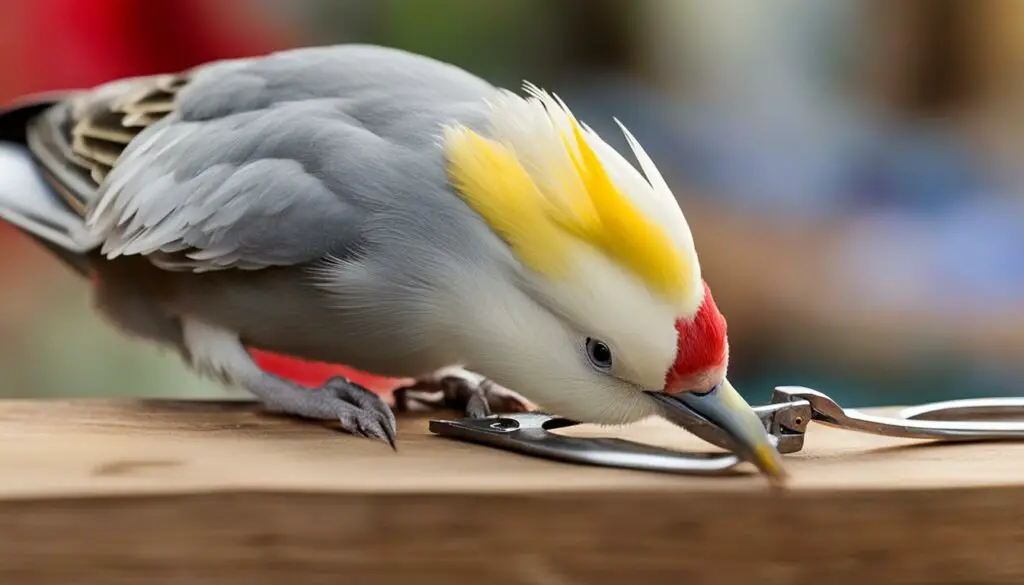
Start by gathering the necessary tools, including a pair of small, pet-specific nail clippers or a nail file. It’s important to choose tools specifically designed for birds to ensure a safe and comfortable trimming experience.
When trimming your cockatiel’s nails, be cautious not to cut too close to the quick, which is the blood vessel inside the nail. This can cause bleeding and discomfort. Instead, aim to trim just the pointed tip of the nail, about 1/8 inch away from the quick.
If you’re uncertain about the correct length to trim, consult a veterinarian or an experienced avian groomer for guidance. They can demonstrate the proper technique and provide personalized tips for your cockatiel’s specific needs.
Table: Cockatiel Toenail Trimming Tips
| Step | Procedure |
|---|---|
| 1 | Gently hold your cockatiel’s foot, ensuring a firm but gentle grip. |
| 2 | Identify the pointed tip of the nail and trim it using the appropriate tool, making sure to avoid the quick. |
| 3 | After trimming, use a nail file or emery board to smooth any rough edges. |
| 4 | Offer your cockatiel a treat or praise to reward them for their cooperation. |
Remember, be patient and take breaks if needed. It’s better to trim a little at a time than to risk cutting too much. Regularly inspect your cockatiel’s nails for signs of overgrowth or any abnormalities, and trim as necessary to maintain their overall foot health.
By following these simple steps and providing regular toenail trimming for your cockatiel, you can ensure their comfort, prevent any mobility issues, and promote their overall well-being.
Toxic Plants to Keep Away from Your Cockatiel
Cockatiels are curious birds that love to explore their surroundings. However, it’s important to be aware that some plants can be harmful to their health. As responsible bird owners, we need to ensure that our feathered friends are safe from toxic plants. Here are some common plants that you should keep away from your cockatiel:
| Plant | Toxicity Level |
|---|---|
| Avocado | High |
| Lobelia | High |
| Clematis | Moderate |
| Oleander | High |
| Poinsettia | Moderate |
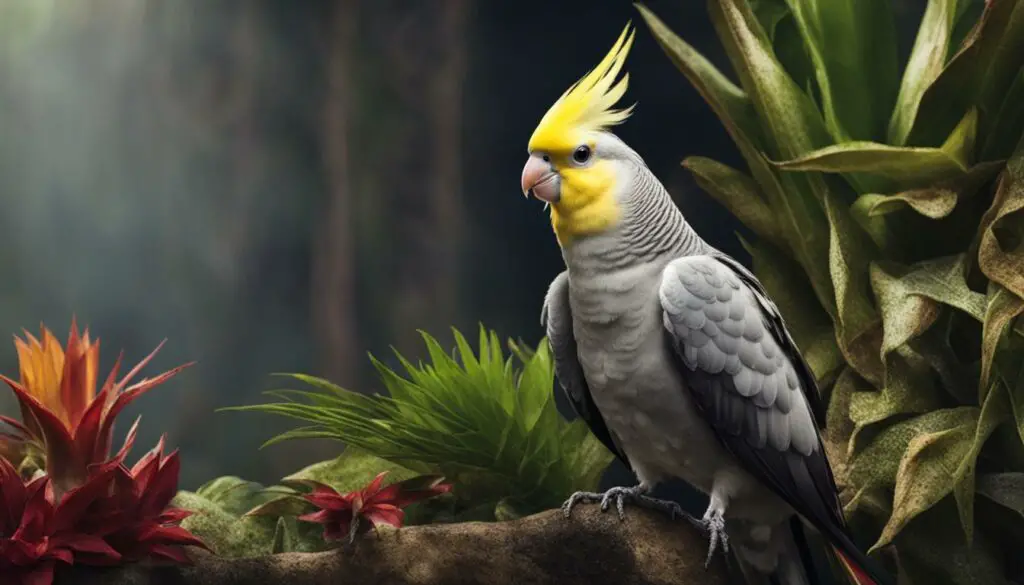
These plants can cause various health issues if ingested by your cockatiel. Avocado, for example, contains a toxic substance called persin, which can be fatal for birds. It’s crucial to keep these plants out of your cockatiel’s reach and never allow them to nibble on any part of the plant.
If you have these plants in your home or garden, make sure they are placed in areas inaccessible to your cockatiel. Regularly inspect the environment where your bird resides to ensure that there are no potential dangers lurking nearby.
Remember, prevention is key when it comes to keeping your cockatiel safe and healthy. By being aware of the plants that are toxic to them and taking the necessary precautions, you can provide a secure environment for your beloved pet.
Cockatiel-Friendly Houseplants: Creating a Safe Environment
If you’re a proud cockatiel owner, you know how important it is to create a safe and enriching environment for your feathered friend. While some plants can be toxic to cockatiels, there are many houseplants that are safe and can coexist harmoniously with your pet. Adding these cockatiel-friendly houseplants to your home not only helps create a lush and vibrant atmosphere but also provides your bird with a stimulating and safe environment.
Safe Houseplants for Cockatiels
Here are some examples of non-toxic plants that are safe for your cockatiel:
- African Violet
- Aloe
- Palms
- Ferns
- Spider Plants
These houseplants not only add beauty to your home but also offer your cockatiel opportunities for exploration and play. The lush green leaves and interesting textures of these plants stimulate your bird’s senses, providing mental stimulation and a sense of connection to nature.
When incorporating houseplants into your cockatiel’s environment, be sure to consider their placement. Avoid placing plants within reach of your bird’s cage, as they may nibble or perch on the leaves, potentially ingesting harmful substances. It’s also important to regularly inspect the plants for any signs of pests or disease, as these can be passed onto your feathered companion.
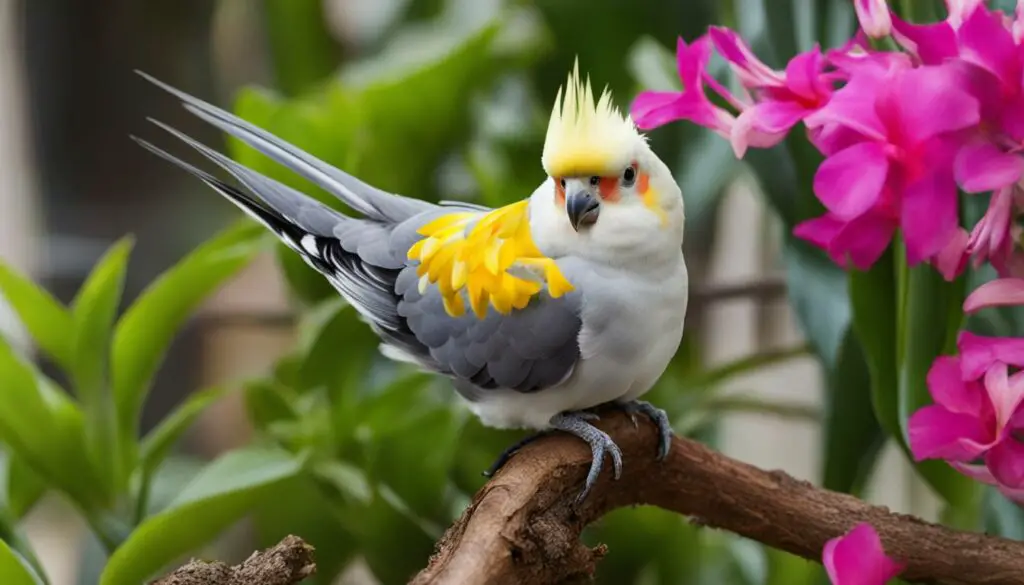
| Plant | Scientific Name | Characteristics |
|---|---|---|
| African Violet | Saintpaulia | Purple or white flowers; fuzzy leaves |
| Aloe | Aloe vera | Succulent plant with healing properties; long, thick leaves |
| Palms | Various species | Glossy, fan-shaped leaves; tropical appearance |
| Ferns | Various genera | Feathery, delicate foliage; thrive in humid environments |
| Spider Plants | Chlorophytum comosum | Long, arching leaves with white stripes; produce plantlets |
By selecting cockatiel-friendly houseplants and taking appropriate precautions, you can create a safe and engaging environment for your feathered companion. The presence of these plants not only enriches your overall home decor but also contributes to your cockatiel’s physical and mental well-being. Remember to always prioritize the health and safety of your pet when choosing houseplants, and consult with a veterinarian if you have any concerns.
Harmful Substances to Avoid for Cockatiel Feather Care
When it comes to the feather care of your beloved cockatiel, it’s crucial to be aware of harmful substances that can pose a risk to their health. Avoiding toxic substances and using cockatiel-safe products is essential for maintaining their well-being. Here are some harmful substances to steer clear of:
Aerosol Sprays
Aerosol sprays, such as air fresheners, deodorants, and hairsprays, can contain chemicals that are harmful to cockatiels when inhaled. These substances can irritate their respiratory system and lead to respiratory issues or even poisoning. It’s best to keep your cockatiel in a well-ventilated area and avoid using aerosol sprays around them.
Pesticides
Pesticides, including insecticides and rodenticides, should be kept out of reach of your cockatiel. These products contain toxic chemicals that can cause harm if ingested by your bird. Ensure that any pest control measures you use in your home are pet-safe and do not pose a risk to your cockatiel’s health.
Nonstick Cookware
The gas emitted from overheated nonstick cookware, such as Teflon pans, can be extremely toxic to cockatiels. When heated above a certain temperature, these pans release fumes that can be deadly to birds. It’s important to keep your cockatiel away from the kitchen when cooking, especially when using nonstick cookware.
By avoiding these harmful substances and opting for cockatiel-safe alternatives, you can ensure that your feathered friend stays healthy and happy. Remember, prevention is key when it comes to caring for your cockatiel’s feathers!
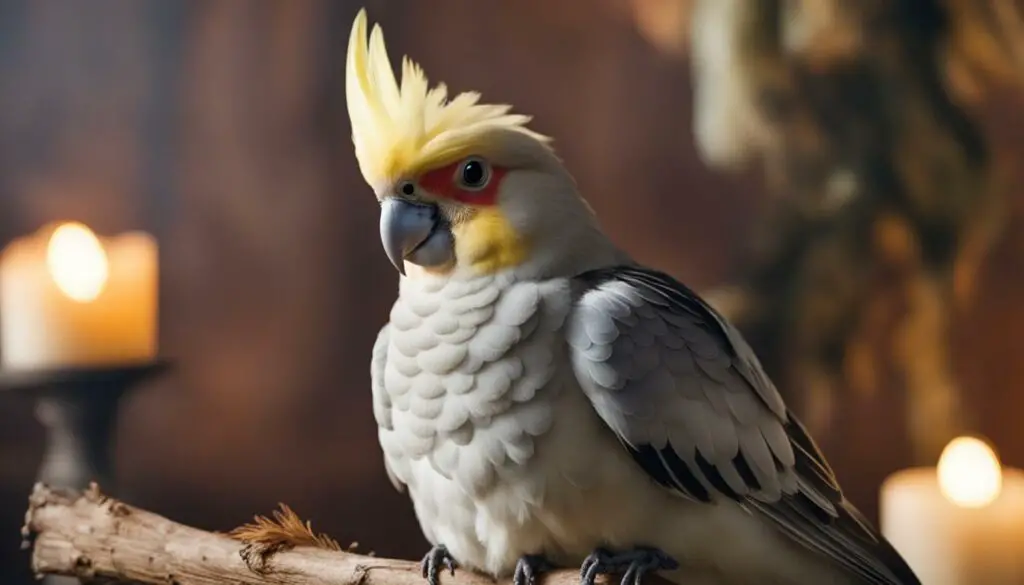
| Harmful Substances | Potential Risks |
|---|---|
| Aerosol Sprays | Irritation of respiratory system Poisoning |
| Pesticides | Ingestion leading to poisoning |
| Nonstick Cookware | Toxic fumes when overheated |
Cockatiel Basics: Overview of Cockatiel Care
When it comes to caring for a cockatiel, it’s important to understand the basics to ensure their health and well-being. These charming parrots require proper care and attention to thrive in your home. Here are the essentials for cockatiel care:
1. Spacious Cage
A spacious cage is essential for your cockatiel’s comfort. It should be large enough to allow for movement and exercise. Provide perches of various sizes and textures to keep their feet healthy. Place toys and interactive objects in the cage to keep them mentally stimulated. Keep the cage clean and well-maintained for a healthy environment.
2. Varied Diet
A balanced diet is crucial for the overall health of your cockatiel. Provide them with a commercial cockatiel seed mix or pelleted diet as the base of their nutrition. Supplement their diet with fresh fruits, vegetables, and leafy greens to ensure they receive essential vitamins and minerals. Avoid feeding them avocados, chocolate, caffeine, and any toxic foods.
3. Mental Stimulation
Cockatiels are intelligent birds that require mental stimulation to prevent boredom and behavior issues. Provide them with toys, puzzles, and interactive games to keep their minds active. Socialize with your cockatiel regularly, as they thrive on interaction and companionship.
4. Regular Veterinary Care
Regular check-ups with a qualified avian veterinarian are essential for your cockatiel’s health. They can conduct thorough examinations, assess their overall well-being, and provide any necessary vaccinations or treatments. Maintain a good relationship with your veterinarian to address any health concerns promptly.
By following these basic care guidelines, you can provide a happy and healthy life for your cockatiel. Remember to always monitor their behavior, eating habits, and physical well-being to catch any potential issues early. Cockatiels make wonderful companions when cared for properly, and with their charming personalities, they will bring joy and happiness to your home.
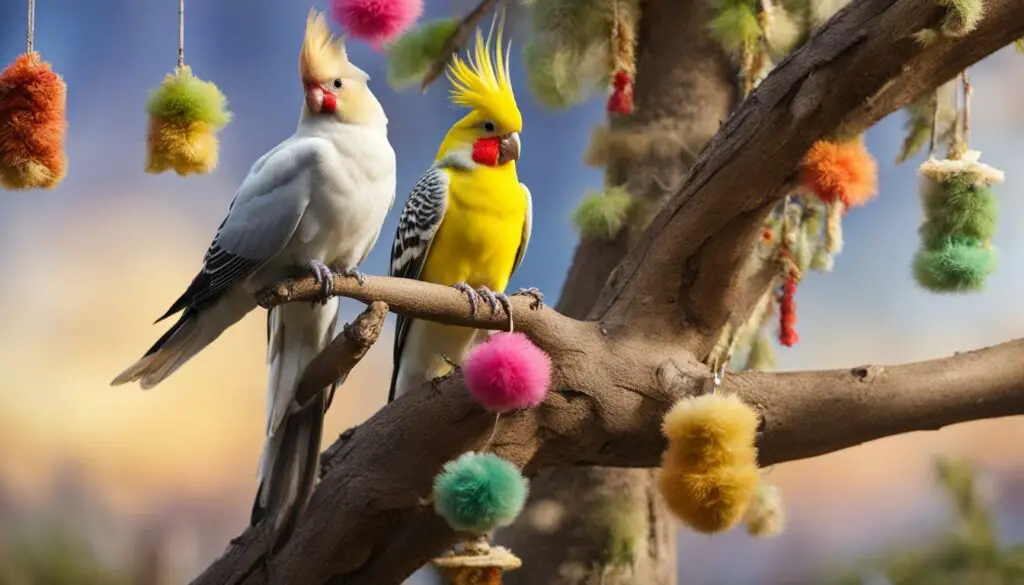
Cockatiel Cage Setup: Creating a Comfortable Home
Creating a comfortable and suitable cage setup is essential for the overall well-being and happiness of your cockatiel. A spacious and appropriately designed cage provides your feathered friend with the necessary space to move, exercise, and explore. Here are some key factors to consider when setting up your cockatiel’s cage:
- Size: The cage should be as large as possible, allowing your cockatiel to spread its wings and move freely. A minimum cage size for one cockatiel should be around 20 x 20 x 24 inches.
- Bar spacing: Ensure that the spacing between the cage bars is appropriate to prevent any potential harm or escape. The ideal bar spacing for a cockatiel is approximately ½ inch.
- Location: Place the cage in a quiet corner of your home, away from drafts, direct sunlight, and loud noises. Cockatiels feel secure and comfortable when they have a peaceful environment.
- Perches: Provide a variety of perches with different diameters and textures to promote foot health and exercise. Natural wood perches are ideal as they mimic the branches found in the wild.
- Toys and enrichment: Offer a range of toys, including puzzles, bells, swings, and chewable toys, to keep your cockatiel mentally stimulated and entertained. Rotate the toys regularly to prevent boredom.
- Food and water dishes: Use sturdy dishes that are easy to clean and securely attach them to the cage. Ensure that fresh food and water are available at all times.
A well-planned cage setup provides a sense of security, comfort, and stimulation for your cockatiel. Remember to clean the cage regularly to maintain a hygienic environment, and provide a comfortable bedding material such as newspaper or cage liners. By creating a safe and enriching home, you will ensure that your beloved cockatiel thrives and enjoys a happy, healthy life.
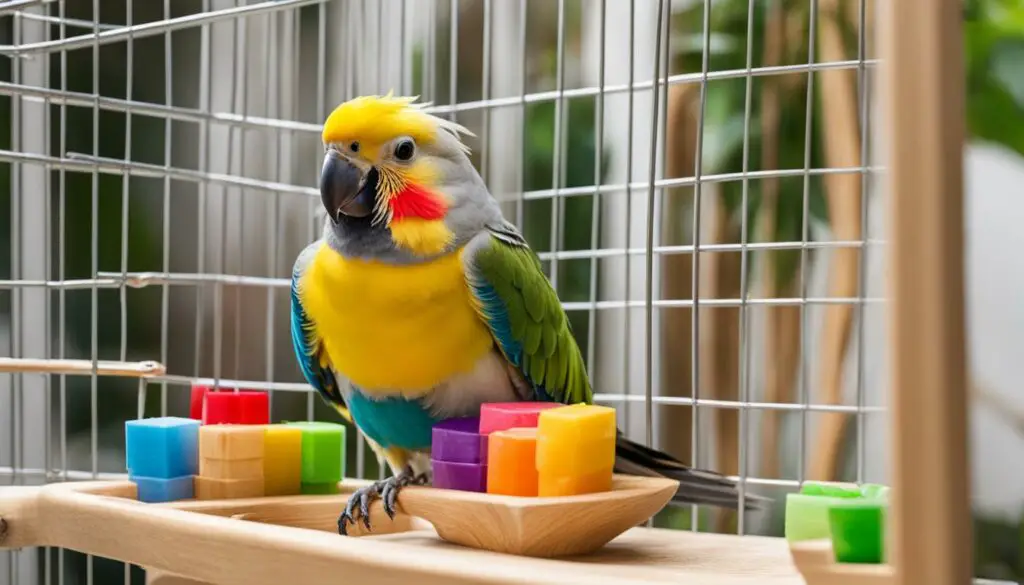
Table: Recommended Cockatiel Cage Accessories
| Accessories | Description |
|---|---|
| Perches | Natural wood perches of various diameters and textures for foot health and exercise |
| Toys | Puzzles, bells, swings, and chewable toys for mental stimulation and entertainment |
| Food and water dishes | Sturdy and easy-to-clean dishes for fresh food and water |
| Bird bath | A shallow dish or container for your cockatiel to bathe in |
| Cage cover | A cover to provide privacy and darkness for better sleep |
Feeding Your Cockatiel: Nutrition and Diet Tips
Proper nutrition plays a crucial role in maintaining the health and well-being of your cockatiel. A balanced diet ensures that your feathered friend receives all the necessary nutrients for optimal growth and development. While a commercial cockatiel seed mix or pelleted diet forms the foundation of their diet, it is important to supplement their meals with fresh fruits, vegetables, and greens to provide additional nutrients and variety.
Table: Recommended Cockatiel Diet
| Food Group | Examples |
|---|---|
| Seeds/Pellets | Cockatiel seed mix, cockatiel pelleted diet |
| Fruits | Apples, oranges, berries |
| Vegetables | Carrots, peas, broccoli |
| Greens | Kale, spinach, parsley |
Offering a variety of foods is important to ensure that your cockatiel receives a well-rounded diet. Avoid feeding them sugary or fatty foods, as these can lead to health problems such as obesity and liver disease. It is also essential to provide fresh, clean water at all times to keep your cockatiel hydrated.
Quote: “A healthy diet is the foundation of a healthy cockatiel.” – Cockatiel Care Expert
Feeding Tips:
- Introduce new foods gradually to allow your cockatiel to adjust to the taste and texture.
- Remove any uneaten fruits and vegetables from the cage after a few hours to avoid spoilage.
- Monitor your cockatiel’s weight to ensure they are maintaining a healthy body condition.
- Consult with a veterinarian to determine the ideal diet and portion sizes for your cockatiel.
By following these nutrition and diet tips, you can provide your cockatiel with a wholesome and balanced diet, promoting their overall health and happiness.
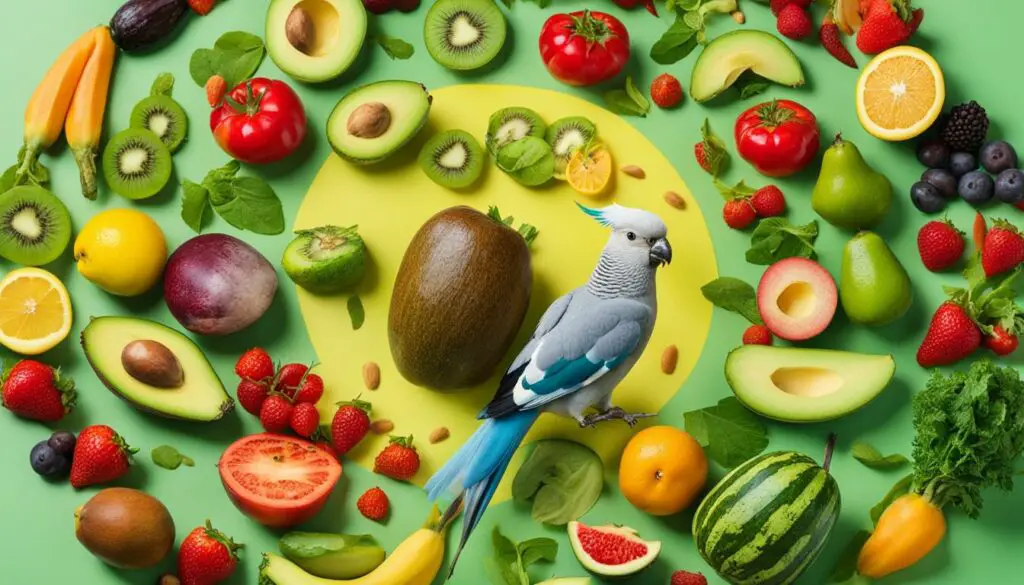
Cockatiel Intelligence and Training
Training cockatiels can be a rewarding and enjoyable experience for both you and your feathered friend. Cockatiels are highly intelligent birds and can learn a variety of tricks and behaviors with proper training and socialization. By dedicating time and effort to training, you can enhance their mental stimulation and strengthen your bond with them.
When training a cockatiel, it’s important to start with basic commands and gradually progress to more complex behaviors. Use positive reinforcement techniques such as treats, praise, and clicker training to reward desired behaviors. Consistency and patience are key, as it may take time for your cockatiel to understand and respond to the training.
Some popular training exercises for cockatiels include teaching them to step up onto your finger, recall training to come when called, and even teaching them to mimic certain sounds or phrases. Remember to keep training sessions short and frequent, as cockatiels have shorter attention spans.
“Training a cockatiel requires patience, consistency, and positive reinforcement. By understanding their intelligence and unique needs, you can create a training program that stimulates their mind and helps them thrive.”
Training Tips for Cockatiels
- Establish a training routine: Set aside regular, dedicated training sessions to work with your cockatiel.
- Use positive reinforcement: Reward desired behaviors with treats, praise, or clicker training.
- Keep sessions short and frequent: Cockatiels have shorter attention spans, so shorter training sessions spread throughout the day are more effective.
- Start with basic commands: Begin with simple commands like step up and recall training before progressing to more advanced behaviors.
- Be patient and consistent: Training takes time and repetition, so be patient and consistent in your approach.
- Provide mental stimulation: Alongside training, offer a variety of toys and challenges to keep your cockatiel mentally stimulated.
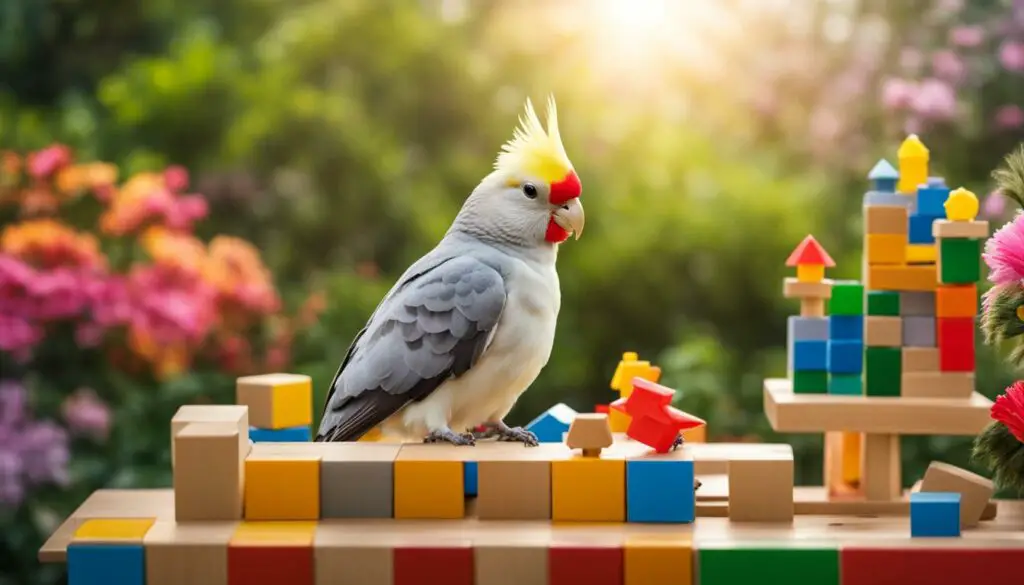
| Training Exercise | Description |
|---|---|
| Step Up | Teaching your cockatiel to step onto your finger when prompted. |
| Recall Training | Training your cockatiel to come to you when called. |
| Mimic Sounds | Teaching your cockatiel to imitate sounds or phrases. |
| Target Training | Training your cockatiel to touch a specific target with its beak or foot. |
| Wave | Training your cockatiel to wave its foot or wing on command. |
Common Health Issues in Cockatiels and How to Prevent Them
Ensuring the health and well-being of your cockatiel is essential for their long and happy life. Like any pet, cockatiels are prone to certain health issues that require attention and care. By understanding the common illnesses that affect cockatiels and taking preventive measures, you can help keep your feathered friend healthy and thriving.
Respiratory Diseases
Respiratory diseases are a common health issue in cockatiels. These can be caused by bacterial or viral infections, as well as environmental factors such as poor ventilation or exposure to cigarette smoke. Symptoms of respiratory diseases include wheezing, sneezing, nasal discharge, and difficulty breathing. To prevent respiratory illnesses, ensure that your cockatiel’s cage is clean and well-ventilated. Avoid smoking near your bird, and keep them away from any household chemicals or strong fumes that could irritate their respiratory system.
Nutritional Deficiencies
Cockatiels require a balanced diet to maintain optimal health. Nutritional deficiencies are a common issue in pet birds, including cockatiels. Lack of essential nutrients, such as vitamin A, calcium, and omega-3 fatty acids, can lead to a variety of health problems, including feather abnormalities, immune system disorders, and even organ damage. To prevent nutritional deficiencies, provide your cockatiel with a varied diet that includes a high-quality commercial seed mix or pelleted diet, supplemented with fresh fruits, vegetables, and leafy greens. Consult with a veterinarian to ensure your bird’s diet meets their specific nutritional needs.
Fatty Liver Disease
Fatty liver disease, also known as hepatic lipidosis, is a common health issue in cockatiels. It occurs when the bird’s liver becomes overwhelmed with fat deposits, leading to liver dysfunction. Fatty liver disease is often caused by a diet high in fats and carbohydrates, lack of exercise, and obesity. Symptoms of fatty liver disease include weight loss, loss of appetite, and lethargy. To prevent this condition, provide your cockatiel with a balanced diet and encourage regular exercise. Avoid feeding high-fat and high-sugar treats, and monitor their weight to ensure they stay within a healthy range.
Psittacosis
Psittacosis, also known as parrot fever, is a bacterial infection that can affect cockatiels and other parrot species. It is a zoonotic disease, meaning it can be transmitted from birds to humans. Symptoms of psittacosis include respiratory issues, fever, fatigue, and digestive problems. To prevent psittacosis, practice good hygiene when handling your cockatiel, such as washing your hands thoroughly after contact and avoiding close contact if you are immunocompromised. If you suspect your cockatiel may be infected, seek veterinary care immediately.
| Health Issue | Symptoms | Prevention Tips |
|---|---|---|
| Respiratory Diseases | Wheezing, sneezing, nasal discharge, difficulty breathing | Provide a clean and well-ventilated cage, avoid smoking near your bird, and keep them away from strong fumes or chemicals |
| Nutritional Deficiencies | Feather abnormalities, immune system disorders, organ damage | Offer a varied diet with a high-quality seed mix or pelleted diet, supplemented with fresh fruits, vegetables, and leafy greens |
| Fatty Liver Disease | Weight loss, loss of appetite, lethargy | Provide a balanced diet, encourage regular exercise, avoid high-fat and high-sugar treats |
| Psittacosis | Respiratory issues, fever, fatigue, digestive problems | Practice good hygiene, wash hands thoroughly after contact, seek veterinary care if infection is suspected |
By being proactive in your cockatiel’s healthcare, you can minimize the risk of common health issues and ensure a happy and vibrant life for your feathered companion.
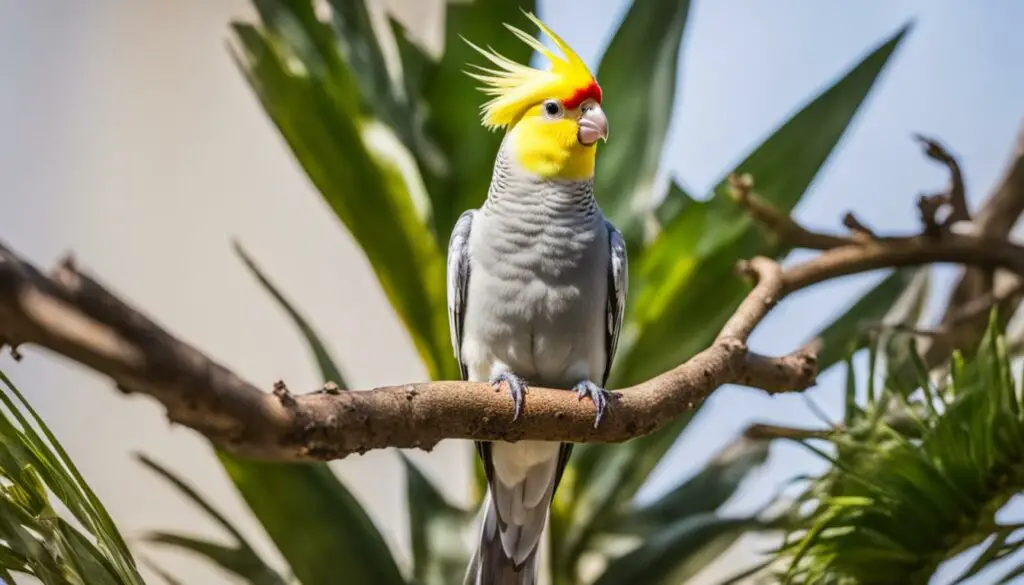
Cockatiel Personality and Behavior: What to Expect
Understanding the personality and behavior of your cockatiel is key to building a strong bond and providing them with the care they need. Cockatiels are known for their gentle and affectionate nature, making them wonderful companions. While they may not be cuddly birds, they enjoy being near their owners and can form strong bonds based on trust and interaction.
Cockatiels are social birds and thrive on attention and play. They love being a part of the family and will appreciate spending time with you. Offering them a variety of toys and challenges will keep their minds active and prevent boredom. Cockatiels can imitate speech and whistle, with male cockatiels often being more vocal than females. They have a knack for learning tricks and enjoy showing off their intelligence.
It’s important to create a safe and stimulating environment for your cockatiel. Providing a spacious cage with plenty of toys and perches will keep them entertained and mentally engaged. Cockatiels are naturally curious, so be prepared for their inquisitive nature and love of exploring their surroundings. They are also diurnal creatures, meaning they are most active during the day and prefer a quiet and peaceful sleeping space at night.
Remember to be patient with your cockatiel as they adjust to their new environment. It may take some time for them to feel comfortable and develop trust, especially if they are a rescue bird or have had a previous negative experience. By understanding their unique personality and behavior, you can create a loving and fulfilling relationship with your cockatiel.
Table: Cockatiel Personality Traits
| Trait | Description |
|---|---|
| Affectionate | Cockatiels are known for their gentle and loving nature, forming strong bonds with their owners. |
| Social | These birds thrive on attention and interaction, enjoying being a part of the family. |
| Playful | Cockatiels love toys and challenges, keeping their minds active and preventing boredom. |
| Curious | With their inquisitive nature, cockatiels are always exploring and investigating their surroundings. |
| Vocal | Male cockatiels are often more vocal, mimicking speech and whistling to communicate and show off their intelligence. |
Remember, each cockatiel is unique, and their individual personalities may vary. Some may be more outgoing and adventurous, while others may be more shy and reserved. It’s important to spend time observing and understanding your cockatiel’s behavior to ensure their needs are met and they feel secure in their environment.
By providing a safe, stimulating, and loving home for your cockatiel, you can cultivate a strong bond and enjoy the companionship of these charming feathered friends.
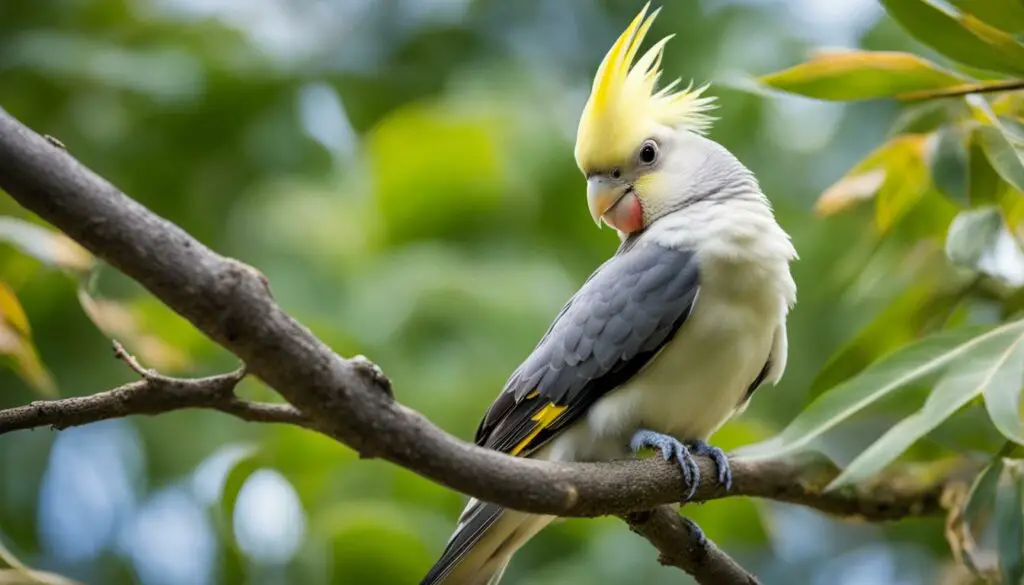
Disclaimer: The information provided in this article is for educational purposes only and does not constitute veterinary advice. For specific concerns and guidance regarding your cockatiel’s behavior, consult a qualified avian veterinarian.
Conclusion
As we conclude our guide on cockatiel feather care essentials, it’s clear that providing ongoing care is crucial for the health and well-being of these charming parrots. By following the tips and guidelines outlined in this article, you can ensure that your cockatiel’s feathers remain healthy and beautiful.
Proper wing clipping and toenail trimming not only contribute to their safety, but also help foster trust and communication with your feathered companion. Additionally, being aware of toxic plants and harmful substances can protect your cockatiel from potential dangers.
Remember, cockatiels are social creatures that require attention and mental stimulation. Providing them with a spacious and comfortable cage, a balanced diet, and opportunities for training and play will ensure they live a happy and fulfilling life.
By implementing these essential feather care practices and maintaining a loving and nurturing environment, you can enjoy the companionship of your cockatiel for many years to come. Take the time to understand their behavior, address their health needs, and develop a strong bond with your feathered friend. Together, you can create a harmonious and enriching life for your beloved cockatiel.
FAQ
What signs indicate that it’s time to clip my cockatiel’s wing feathers?
Signs that it’s time to clip your cockatiel’s wing feathers include gliding with ease, completion of a molt, and behavioral changes in male cockatiels. Trimming an occasional stray feather may also be necessary.
Why is trimming my cockatiel’s toenails important?
Trimming your cockatiel’s toenails is important for their comfort and safety. Signs that it’s time for a trim include sensitivity and discomfort for younger and older family members, snagging nails, overgrown nails threatening the footpad, nails wrapping around each other, and foot injuries or defects.
What plants should I keep away from my cockatiel?
Some plants that are toxic to cockatiels include avocado, lobelia, clematis, oleander, and poinsettia, among others. It’s important to prevent your cockatiel from nibbling on these plants to keep them safe and healthy.
Can I have houseplants if I have a cockatiel?
Yes, there are many houseplants that are safe for cockatiels. Examples include African violet, aloe, palms, ferns, and spider plants, among others. These plants can coexist harmoniously with your feathered friend.
What harmful substances should I avoid for cockatiel feather care?
It’s important to avoid exposing your cockatiel to substances such as aerosol sprays, smoke, pesticides, cleaners, room fresheners, and the gas emitted from overheated nonstick cookware. These substances can be harmful to their health.
What are the basic care requirements for a cockatiel?
Cockatiels require a spacious cage, a varied diet, mental stimulation, and regular socialization. They are relatively low-maintenance pets but need attention and interaction to thrive.
How should I set up a cage for my cockatiel?
The cage should be as large as possible to allow for movement and exercise. It’s important to place the cage in a quiet corner away from loud noises and direct sunlight. Offering a variety of toys and perches will keep your cockatiel entertained and mentally stimulated.
What should I feed my cockatiel?
A balanced diet for your cockatiel includes a commercial cockatiel seed mix or pelleted diet, supplemented with fresh fruits, vegetables, and greens. Fresh clean water should also be provided at all times.
Can cockatiels be trained?
Yes, cockatiels are highly intelligent birds that can be trained. They can learn tricks and imitate sounds with proper training. Spending time interacting with your cockatiel and providing a variety of toys and challenges will keep their minds active and their behavior in check.
What are common health issues in cockatiels, and how can I prevent them?
Cockatiels are prone to nutritional deficiencies, fatty liver disease, respiratory diseases, and psittacosis. Providing a varied and balanced diet, regular veterinary check-ups, and a clean and safe environment can help prevent these health issues.
What can I expect from my cockatiel’s personality and behavior?
Cockatiels are known for their gentle and affectionate personalities. They enjoy being near their owners and can form strong bonds. They are social and thrive on interaction and play. Cockatiels can become loyal and affectionate companions when trained and socialized properly.
Source Links
- https://www.thesprucepets.com/cockatiels-as-pets-1236728
- https://parrotessentials.co.uk/parrot-information-blog/cockatiel-profile-and-care-guide/
- https://www.dummies.com/article/home-auto-hobbies/pets/birds/cockatiels-for-dummies-cheat-sheet-209480/

